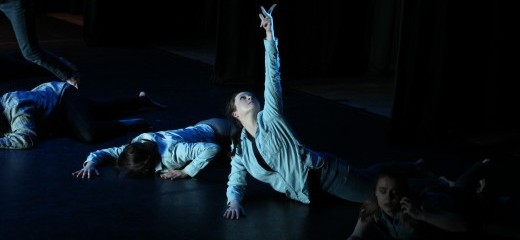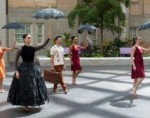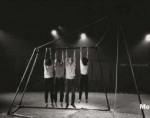
Citizen Displaced
by Andrew Sargus Klein
I was able to write the following about Citizen Displaced because the performance was streamed on Facebook Live. Watching via livestream isn’t ideal, of course, but the experience was primarily good and left me with this thought: As video streaming becomes easier and cheaper, it’s worth reframing the technology through the lens of access and audience, considering differently abled bodies and people without the financial or logistical means to attend a performance.
+
Citizen Displaced, a collaboration between the University of Maryland School of Music and Department of Dance, “seeks to bring awareness to the Refugee Crisis.” It consists of eight musicians and seven dancers with music by Pablo Salazar, choreography by Christine Hands in collaboration with the dancers, and direction by David Flyr.
The work opens with a direct sense of discomfort. The musicians, playing atonal notes held for long durations, circle the dancers, who form a single, writhing body. When the musicians line up, upstage, the group dancing expands across the entire floor, on hands and knees, running and sliding in unison; a body is slung over another and carried offstage as the lights dim.
Both the score and the choreographic choices, employing implicit and explicit narratives of displacement, turmoil, and fear, follow recognizable, classical modes, with Rite of Spring as a loose and accessible reference point.
As the score darkens turbulently, the dancers move as if in water, swimming and thrashing, desperate. This is a moment where the choreographic choices feel too literal, given the seriousness of the theme. The polish of the score and the technical abilities of the dancers seem, to me, at odds with the visceral quality of news reports. Yet Salazar and Artistic Consultant Anto Meliksetian, immigrants escaping turmoil in Bolivia and Syria, respectively, made deliberate choices. The score is gorgeous—expressive, layered, thoughtful, dramatic. Executed at a high skill level, it expresses trauma with both exaggeration and grace.
The second section is introduced with plinking, ominous music-box sounds and a sense of death, isolation, and aloneness as a body lies on the ground, bathed in blue light. The dancer rises and begins a solo, which evolves into a hectic duet that doubles into a quartet. Then there are six dancers and a remarkable movement sequence: all six bodies slowly spinning in place, offset by one or two dancers spinning faster in an uneasy peace that also expresses underlying, ever-present dissonance. Another special moment: The dancers line up behind the violist and they all walk the width of the stage. As the cellist pulls her bow the dancers mirror her and expand the gesture—a hand sweeping up high, then diving back and across the abdomen.
The most arresting section of the score is a quartet with flute, oboe, clarinet, and French horn. The tempo picks up with staccato brass, the oboe and clarinet at odds with each other, then in concert—calm, then weary. The tight contrapuntal execution builds with ominous energy, then resolves with a gentle placidity. The dancers return. Both lighting and score darken, the quartet slowly building and releasing tension, over and over, a seesaw effect. The dancers move as a group, stretching hands upward, gracefully and loosely in unison, as the score deepens into constrained cacophony. The dancers stoop low, then return upright, firmly grounded, spiraling their upper torsos, expanded by the arms. The strings trill away in an undertone of strain, even as the choreography stays languid, albeit cautious.
The performance concludes with a mesmerizing viola-cello duet. The musicians face each other in a tender, intimate moment. A dancer encircles them, but my attention is on the bows, on the musicians looking at each other. Then the violist, paired with the dancer, orbit each other in a solemn decrescendo—a haunting end to the work.
Citizen Displaced, Pablo Salazar and Christine Hands, The Clarice Performing Arts Center, March 15.
By Andrew Sargus Klein
April 2, 2018






.png)


